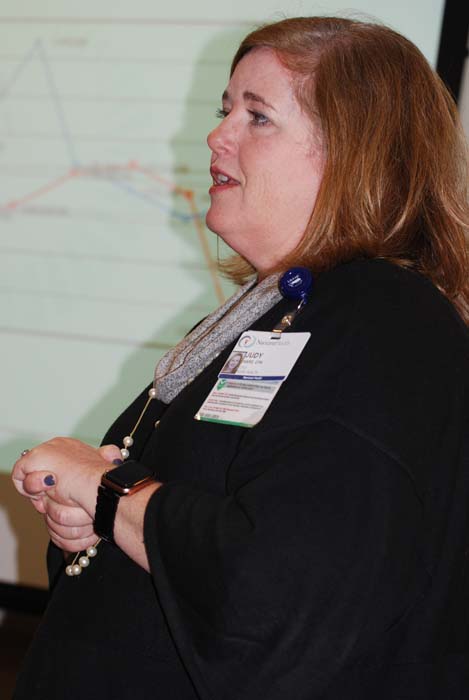Local hospital reaches financial milestone
Published 12:15 pm Thursday, February 21, 2019

- Judy Ware, regional chief financial officer for Navicent Health, talks to members of the Navicent Health Baldwin hospital board of directors on Tuesday about the financial improvement shown at the local hospital over the past year. The net patient revenue between January 2018 and January 2019 was $1 million.
MILLEDGEVILLE, Ga. — When Judy Ware told members of the Navicent Health Baldwin hospital board of directors that she had nothing but good news to share with them at Tuesday’s meeting, she wasn’t kidding.
The good news comes in the form of a newly released analysis or net patient revenue at the hospital in Milledgeville.
The January 2019 figures show an increase of $1 million over January 2018, Ware said.
The latest figures reveal a net patient revenue of $4.9 million, as compared to a year ago for the same month when the figure was $3.97 million. The net patient revenue for the first month of 2017, meanwhile, was $3.95 million.
Under the merger between Atrium and Navicent Health, the local hospital is now working under a calendar budget year as opposed to a fiscal year.
“So the October, November and December financials are called what we are terming a sub-year,” Ware explained. “And we’re kinda part of the past. In addition to that, we had to undergo a new budgeting process to develop a calendar year budget from Jan. 1 until Dec. 31. So, we are still in the process of fine tuning that budget.”
A draft of the budget was presented to the chairperson of the hospital’s finance committee during last Friday’s meeting, Ware said.
Among the items included in the budget proposal are some high-level, top-level revenues and the projected amount in expenses, she said.
“I’m happy to say that we project a break-even margin for the 2019 calendar year,” Ware said, noting that a breakdown of the budget by department is still a work in progress and that she hopes it will be ready for the review by the finance committee and hospital board soon.
In converting from the former budget system to the new one, Ware said there were some snags along the way.
One of the big reasons for such was “because we were quickly pivoting to try and make those projections and the system was built on a fiscal year, and making all those modifications in a short time period, we had a few hiccups in those projections where it overrode some of our logic and we had to go back,” Ware said.
The 2017 net patient revenue came at a time when the local hospital was still known as Oconee Regional Medical Center. It later was purchased by Navicent Health.
“The hospital (ORMC) at that time had a negative $1.2 million loss,” Ware said. “Last January, we had around a $657,000 loss. And this January 2019, we had a net operating margin of $291,000.”
Ware called it “a very positive trend.”
“We have turned the corner and are doing a really good job at growing our volume, or recapturing our volume, and maintaining the census,” Ware said.
One of the main reasons for the net patient increase is that the hospital volume is up, she explained.
‘It’s plain and simple,” Ware said. “So that’s a good thing.”
Another reason is that the hospital has had some charge increases to maximize its reimbursement and to make sure they fall in line with the market, she said.
Hospital officials want to continue minimizing expenses.
Operating expenses for January of this year were $4.26 million she pointed out. In January 2017, operating expenses were $4.96 million, and in January 2018, they were $4.3 million.
“How did you decrease the expenses,” asked Peter Boylan, who serves as chairman of the hospital board.
Ware quickly replied with one word — “Efficiency.”
Another way has been through staffing measures, she said.
Ware said Lorraine Daniel, director of nursing at the hospital, had worked on a staffing matrix and held department managers accountable.
“So, if our volume does decrease or falls, then we react quickly, and then bring them back in when the volume goes up,” Ware said. “So we look at that on a probably at least every couple of hours. We have also been able to — say for example — IT (Information Services), we have been able to streamline that and have support from corporate and HR (Human Resources) and accounting — all of those functions have been able to be streamlined, and getting more for less.”
Those areas have been a focus and continue to be, Ware said.
Additionally, hospital officials have minimized expenses with purchasing contracts, whether it was involving its pharmacy or supplies.
A couple of other examples included salaries and benefits.
“In January they were lower than what we forecasted and that would be because we do still have some vacancies, so our contract labor was higher,” Ware said.




